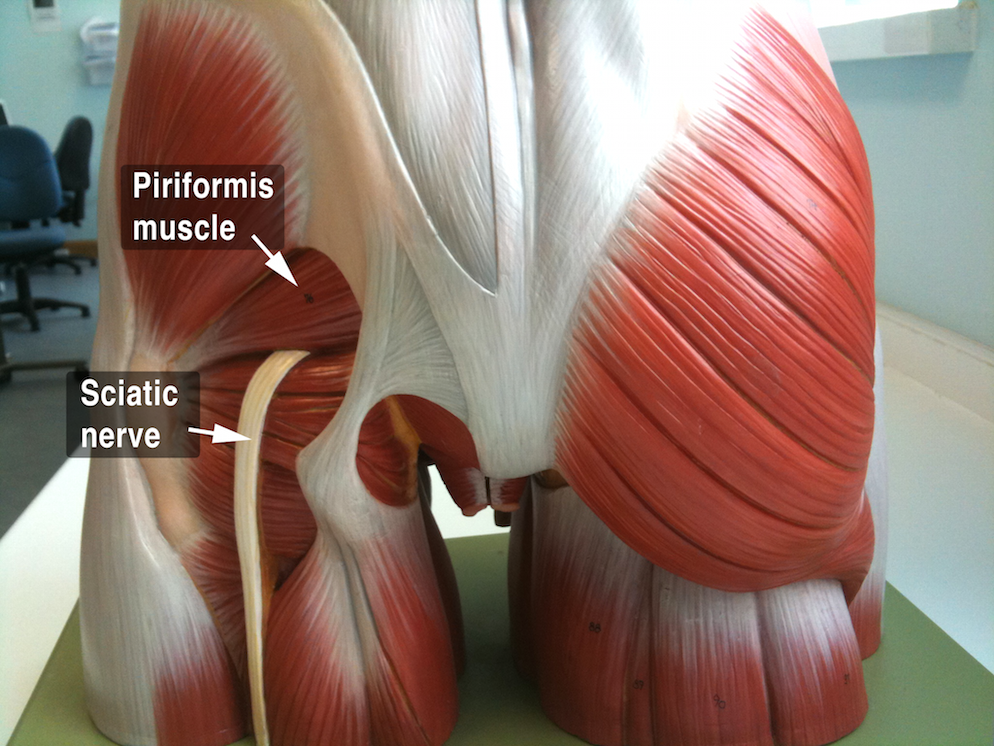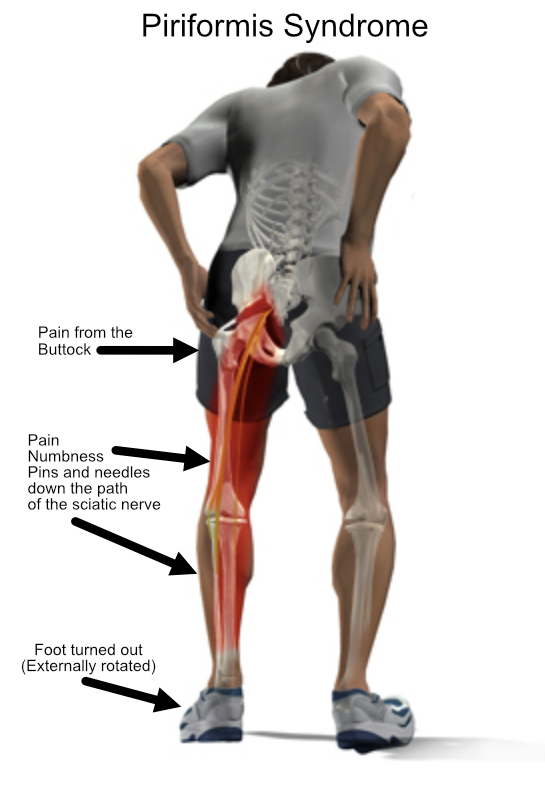Piriformis syndrome is irritation of the sciatic nerve at the point where the nerve lies under or between the Piriformis muscles. Its symptoms are similar to sciatica caused by a disc prolapse in the lumbar spine, with pain down the leg.
The Piriformis is a small muscle lying behind the larger Gluteus Maximus muscle, from the hip to the sacrum. It rotates the hip, turning the foot out in external rotation. The sciatica nerve lies under the Piriformis muscle, on in some people between the Piriformis muscle.
If the muscle is strained from overuse in sport or as a complication of tightness in the sacroiliac joints, then there can be irritation around the muscle, pressing or irritating the sciatic nerve.

Symptoms of Piriformis Syndrome
- Tenderness or pain from the buttock on one side down the leg
- Pain doesn’t necessarily arise from the back
- Clients are often very clear that the pain starts from the buttocks
- The leg may be rotated so the foot on the painful side turns out ‘duck-footed’. This releases the piriformis muscle and so reducing pressure on the sciatic nerve.
- Sciatic pain, numbness down the back of the thigh to the calf or foot.
- Pain is often worse climbing stairs
- Pain is worse after sitting
Clinical signs of Piriformis Syndrome
- Weakness in the piriformis muscle on muscle testing
- Rotated foot on walking (duck-footed)
- Tenderness, inflammation in the buttock and piriformis muscle
- Neurological signs of sciatica can be present, but in my experience are less severe than sciatica from a herniated disc

Piriformis Syndrome vs Sciatica from a lumbar spine disc
It’s not always clear-cut whether sciatica is caused by a piriformis syndrome spasm, or a herniated disc. The issue becomes more confusing as MRI scans can show asymptomatic disc herniations so it’s not always a simple matter of just taking an MRI scan. It’s quite possible on occasions the sciatic nerve could be irritated both in the lumbar spine from a disc herniation, and also by the piriformis muscle, which is a called a ‘double crush syndrome’, where the nerve is irritated in two places. Commonly the diagnosis can be made somewhat retrospectively, after treatment, as my experience in practice is that piriformis does settle much quicker than a herniated disc.
Chiropractic Treatment of Piriformis Syndrome
Piriformis syndrome has a very good prognosis and Chiropractic can be an excellent treatment. Because it is more of a muscle injury than a ligament or cartilage injury it can heal quite quickly (see musculoskeletal injuries and healing times). However, if the nerve has been irritated for a long time, that can of course take longer to fully heal.
Piriformis syndrome related to Sacroiliac joint and pelvic tightness
It’s very common to find that piriformis syndrome is related to locking or tightness in the pelvic region.
Chiropractic treatment plan for Piriformis Syndrome
- Restoring the movement and balance in the pelvis, sacroiliac joints and the lower lumbar spine is a key factor, as imbalance causes the tension, irritation and spasm in the piriformis muscle. Chiropractic is very effective in this regard.
- Mobilizing and releasing of the piriformis and gluteal muscles
- Deep massage and trigger point treatment to the tightness in the piriformis, pelvic and gluteal muscles
Self-help for Piriformis Syndrome
- Avoid sitting too long
- Exercises for Piriformis muscle can vary for each individual:
- Swimming, cycling, cross-trainer
- Walking if this is comfortable, even if short distances
- Stretching exercises for the Piriformis muscle
Piriformis stretches
Knee to chest stretch
Lie on the back pulling the right knee up to the chest and across to the left shoulder, holding the stretch. You should feel tension or pull in the buttock area.
Lie on the back with knees flexed pointing to the ceiling, both feet flat on the floor. Put the right ankle over the left knee. Pull the left thigh toward the chest and hold the stretch.
Each piriformis stretch should be held gently for about 10 seconds initially, increasing to 30 seconds.
Stretch both sides, starting with the non-painful side and do this a few times a day.
Hamstring stretches
Sit on a chair and place your heel of one leg on another chair in front of you. Lean forward from the hips until you feel a gentle pull along the back of the thigh.
Lie on the back with both legs straight. Wrap a towel around one foot and pull the leg up straight until a pull on the back of the thigh is felt. You can do this with the leg up on a chair if required.
An excellent demonstration of piriformis muscle stretches can be found at https://www.spine-health.com/video/piriformis-syndrome-video
There is also very good video about Pirifomis syndrome from Veritas Health:
https://www.spine-health.com/video/piriformis-syndrome-video?source=tdw
If you have any doubts please give us a call for advice and to schedule a Chiropractic treatment if necessary.